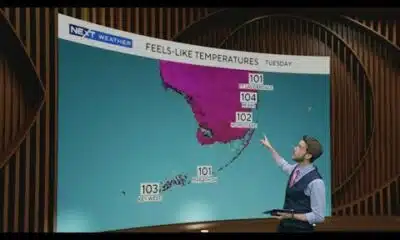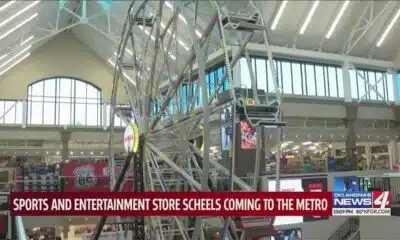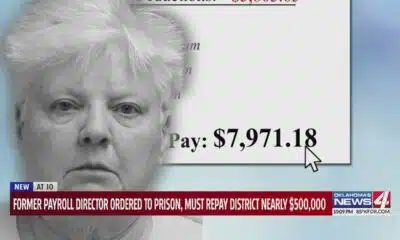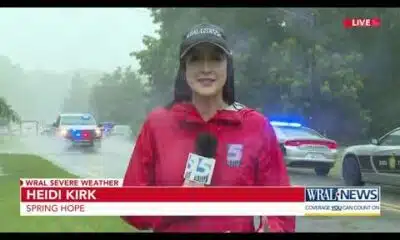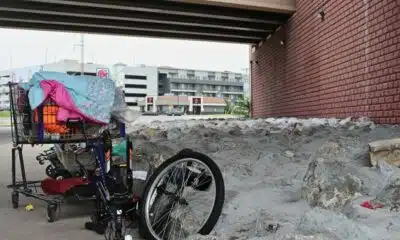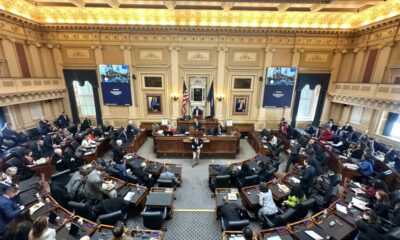News from the South - North Carolina News Feed
When it comes to climate change, are we doomed? It sure looks that way, but we can do something about it • Asheville Watchdog
One of these days, I promise, I’ll spread some Christmas cheer.
But today, my gift is a little, well, doom-ish. Before you fire off an email calling me Scrooge McChristmaskiller, hear me out.
I’m going to recap a fascinating climate discussion held earlier this month, which included high-profile scientists — and a touch of hopeful news. Sure, overall it’s a little bleak, but we have the power to make it less so.
How’s that for a sales pitch?
On Dec. 4, Congregation Beth HaTephila and several other sponsors brought in prominent climate scientist and energy systems analyst Zeke Hausfather, described pre-event as a “world-class, oft quoted climate scientist.” Local climate scientists David Easterling of the National Centers for Environmental Information in Asheville; and Andrew Jones, executive director and cofounder of Climate Interactive in Asheville, also presented to a packed house at The Collider downtown.
To give you a dose of hope early on, I’ll tell you Jones pitched the En-ROADS Climate Solutions Simulator, which is super cool and lets you play around with potential climate solutions and see how much various options can reduce global temperatures. Give it a try.


But here’s the bad news. Hausfather noted that between the 1850s, when reliable global temperature records became available, and the early 1900s, temperatures “went up and down year to year, but there wasn’t really that much of a change.’’
“But since 1970 the earth’s temperature has been rising fairly rapidly,” Hausfather said. “And now, as of 2024, we’re seeing temperatures close to 1.5 degrees (Celsius) above pre-industrial levels.
“And these levels of temperatures, just like levels of CO2, are unprecedented for a very long period in the Earth’s history. So temperatures today are probably higher than we’ve seen for at least 120,000 years, potentially further back than that.”
OK, have a great week. I’m getting on a rocketship for a trip to a reserve Earth-like planet in the Goldilocks zone. I’m pretty sure Elon Musk is moving there, too.
Seriously, Hausfather’s statistics aren’t good, especially when you consider 1.5 degrees Celsius is 2.7 degrees Fahrenheit – and when you consider that about 40 percent of the carbon dioxide we pump into the atmosphere stays there, which means temperatures will likely stay up for a while.
“Certainly, we know that if temperatures stay at today’s levels, they will be there for a century or so,” Hausfather said.
All of this ties in locally because we keep having warmer seasons and we have an increased chance of more devastating storms like Helene, which caused extensive flooding, landslides, and loss of life Sept. 27. We also see more heavy rains in general, as well as droughts that contribute to wildfires out west.
This all comes down to human activity – everything from using coal-burning power plants and factories to driving gas-powered vehicles.
Climate change: We’re the cause of it
I’m always amazed when people don’t believe global warming is real, or they acknowledge it is happening but say there’s no way people are causing it. Hausfather addressed the latter first.

“So I often get a question from people when I’m talking about climate change, of, ‘How could humans really affect the climate? It’s so big.’” Hausfather said. “Planet Earth is so massive, and I think people don’t really understand just how big an impact humans have had in terms of the atmosphere.”
We really like to burn fossil fuels, which emit a lot of carbon dioxide.
“We have burned a mind-numbing amount of carbon,” Hausfather said. “We have burned about 2.6 trillion tons of carbon dioxide since the Industrial Revolution, the vast majority of that in the form of fossil fuels.”
We’re also proficient at removing trees, which consume CO2 and produce oxygen, and that is cooking our own goose, too.
Hausfather put those 2.6 trillion tons of carbon dioxide in perspective.
“That’s roughly the same amount of mass as every living thing on earth, plus everything ever made by humans — the pyramids, all of our roads, all of our buildings combined,” he said. “We have burned that much carbon and put that much carbon dioxide up into the atmosphere, and that’s dramatically changed the composition of our atmosphere.
“Now, about 40 percent of that carbon dioxide has accumulated in the atmosphere, about 1.1 trillion tons. The remainder, thankfully, has been absorbed back into the Earth’s system, primarily into the ocean and into the biosphere.”
That’s good, because climate change “would be twice as bad if the earth weren’t helping clean up some of our mess,” he noted, adding that Earth is getting worse at cleaning up our mess.
Scientists can study tree rings, stalactites, ocean corals and ice cores for information on global temperatures going way back, before recorded history.
I kind of wish they hadn’t.
“We have not seen a period in the Earth’s history where carbon dioxide concentrations have been this high for at least over 3 million years, potentially 4 million,” Hausfather said. “And in the period where it was much higher, the earth’s temperature was much, much hotter than it is today.”
Today, we can measure the effects of our human activities, so it’s not like declaring what’s fueling global warming is speculation.
“This isn’t just supercomputer models that we throw a bunch of fancy equations into,” Hausfather said. “We can measure this. We can measure it by satellites. We can measure it by ground sensors.”
It gets worse, because we’re pumping out other greenhouse gas emissions like methane and nitrous oxide that contribute to warming, as well as aerosols, such as sulfur dioxide emissions, that are essentially suspended particles in the atmosphere.
“These get a lot of press because of their really bad health impacts,” Hausfather said. “Somewhere around 7 million people die each year globally, particularly in Asia, from outdoor air pollution, and most of that is particulate matter that is derived from sulfur dioxide.”
Because sulfur dioxide reflects light back into space, it actually cools the climate, he said, describing “global dimming,” which happens because the sky is so hazy, particularly in Asia.
This is also really bad, because it masks some of the warming we’ve had.
Merry Christmas and Happy Hanukkah! And brace yourself …
We’ve got to clean up the pollution, Hausfather said, which is mostly caused by burning fossil fuels, to solve climate change.
“But this does create a dilemma for us, because as we clean up the air and as we switch away from fossil fuels, a lot of additional warming that we’ve been masking is going to come back to bite us, and that’s a challenge,” Hausfather said.
I’ve got to imagine this guy has single handedly killed more parties than Charles Manson.
The effects on storms like Helene
But hey, we haven’t even gotten to the Helene stuff!
If you warm the planet by one degree Celsius, you get about 7 percent heavier rainfall, the scientist told us.
“Now for tropical cyclones or hurricanes … we see a magnification of somewhere closer to 10 to 15 percent increased rainfall from these intense storms and hurricanes in a warming world,” Hausfather said.
How big an impact this had on Helene is still an area of active scientific research, he noted, although a few early studies have pegged the increased rainfall due to climate change at 10 to 50 percent. It clearly had an effect, though Helene would’ve been catastrophic any way you slice it.
Easterling, who lives in northern Henderson County, pointed out that during Helene and the precipitation a couple days before, his gauge recorded 15 inches of rain.
That exceeded the 1,000-year rainfall amount by about 3 inches. Easterling noted these thresholds for 1,000-year events or 100-year or 500-year events are based on older data, and even an update coming in the next few years is probably going to underestimate future intensity of rainfall.
“The bottom line is, as the atmosphere warms, there’s more moisture in the air, and that (increased) moisture in the air is available to rain out in heavier events,” Easterling said.
It gets a bit worse, as Hausfather noted when he continued.
“The last two years, 2023 and 2024, have been particularly exceptional,” he said, pointing to one of his many charts. “And so we are well above anything we’ve seen previously in the climate, even in the last few decades.”
Scientists aren’t quite sure why.
This year, some parts of the world are going to come in a little bit above 1.5 degrees Celsius from pre-industrial levels, “which is the sort of temperature target the world set itself during the Paris agreement to, ideally, not exceed.” That refers to the 2015 Paris Climate Accords.
“You know, we don’t want to be pushing up against that target already, especially this early,” Hausfather said. “And these big jumps in temperature have really pushed us there.”
The entire planet is on track to breach the 1.5 degree limits in the next decade, perhaps as early as the late 2020s or early 2030s, Hausfather said. The goal from Paris was to limit global warming to well below 2 degrees Celsius and preferably 1.5 degrees.
To do that now, Hausfather said, we’d have to cut global emissions to zero over the next decade.
There is some hope
If you think this talk was dark thus far, keep in mind I’ve left out a fair amount of detail. Even Hausfather acknowledged he could’ve been wearing a black cloak and toting a sickle.
“So that’s kind of the grim side of the talk, but I’m going to leave you guys with a little bit of optimistic things, too, because it’s not all doom and gloom,” Hausfather said.
Global carbon dioxide emissions have flattened over the last decade and the reasons are encouraging.
“A big part of it is that we’ve succeeded in making clean energy cheap,” Hausfather said. “Things like solar energy are the cheapest form of new energy in almost all the world today. The cost of solar batteries have fallen by more than 90 percent over the last decade. Cost of wind (power) has fallen.”

Electric vehicles, bikes, heat pumps, and more have become ubiquitous, especially in China.
“And the world is spending a lot more money on clean energy,” Hausfather said.
Clearly, we cannot become complacent, and we have to do more.
Jones, the Climate Interactive co-founder, had the audience shout out ways we can “bend the curve” — bring those global temperatures down. We all made suggestions for the En-ROADS page. There, you can move slider bars up or down on all kinds of potential ways to help, ranging from curbing deforestation and agricultural emission to boosting energy efficiency and employing more electrification.
Boost renewable energy and cut coal usage, and the increase in global temperature drops.
It’s pretty cool to watch, and the graphics are great. And it showed we can drop the warming.
Buy an electric lawn mower (on my list for the spring), an electric vehicle, or at least a hybrid. Maybe buy an electric bike, or get a more efficient heat pump or refrigerator.
Yes, this night was sobering, and a little depressing. But the situation is not hopeless.
We just can’t keep doing nothing and hoping for the best.
Asheville Watchdog is a nonprofit news team producing stories that matter to Asheville and Buncombe County. John Boyle has been covering Asheville and surrounding communities since the 20th century. You can reach him at (828) 337-0941, or via email at jboyle@avlwatchdog.org. The Watchdog’s local reporting during this crisis is made possible by donations from the community. To show your support for this vital public service go to avlwatchdog.org/support-our-publication/.
Related
The post When it comes to climate change, are we doomed? It sure looks that way, but we can do something about it • Asheville Watchdog appeared first on avlwatchdog.org
News from the South - North Carolina News Feed
In Depth with Dan: Answering viewer questions about flesh-eating bacteria, digital licenses
SUMMARY: In this Monday mailbag, Dan addresses viewer questions on three topics. First, North Carolina’s Vibrio bacteria risk in summer coastal waters: cooked shellfish is safe, but raw consumption is risky due to bacteria concentrating in oysters. Second, digital driver’s licenses in North Carolina face delays; although legalized in 2023, full rollout may not occur until 2026, with other states also lagging behind. Lastly, Dan explains flood-damaged vehicles after recent storms: flooded cars must be branded as such, but scams occur. He shares tips to spot flood damage when buying used cars, emphasizing caution and thorough inspection.
WRAL anchor/reporter Dan Haggerty answered viewer questions about a flesh-eating bacteria in North Carolina and the legalization of digital driver’s licenses.
News from the South - North Carolina News Feed
The latest update on Tropical Storm Erin
SUMMARY: Tropical Storm Erin is forecast to become a Category 1 hurricane by Thursday and remain well out to sea through Saturday, near the Lesser Antilles northeast of Puerto Rico. Models show it moving west, then curving north toward Bermuda or Florida, but uncertainty remains high beyond next week. The American and European models suggest it could pass between Bermuda and Hatteras, causing higher surf midweek. Due to large forecast errors, the storm’s exact path is unclear, ranging from north of New York to the Florida panhandle. Residents should prepare hurricane kits and stay updated, with clearer guidance expected by Thursday or Friday.
Will Erin cause problems for the East Coast? Here’s the latest on Monday evening.
https://abc11.com/post/tracking-tropics-tropical-storm-erin-forms-eastern-tropical-atlantic-cabo-verde-islands/17499988/
Download: https://abc11.com/apps/
Like us on Facebook: https://www.facebook.com/ABC11/
Instagram: https://www.instagram.com/abc11_wtvd/
Threads: https://www.threads.net/@abc11_wtvd
TIKTOK: https://www.tiktok.com/@abc11_eyewitnessnews
X: https://x.com/ABC11_WTVD
News from the South - North Carolina News Feed
Body of missing NC teen found in Florida, family says
SUMMARY: The body of missing North Carolina teen Gio Gio was found in Bradenton, Florida, confirmed by his family. Originally, Gio Gio was supposed to be picked up by relatives after meeting cousins in Florida, but he disappeared after texting his mother for help. His family’s private investigators, not the police, discovered his body near I-75 after police had initially searched the area. Gio Gio’s mother expressed her heartbreak on Facebook, calling it every parent’s worst nightmare. The investigation continues, focusing on the timeline after Gio Gio entered the car with his cousins. An autopsy is pending, with no immediate signs of foul play.
The body of Giovanni Pelletier was found in a retention pond, authorities said, and his mom is living “every parent’s worst nightmare.”
https://abc11.com/post/giovanni-pelletier-body-missing-18-year-old-north-carolina-found-pond-where-last-seen-family-says/17483056/
Download: https://abc11.com/apps/
Like us on Facebook: https://www.facebook.com/ABC11/
Instagram: https://www.instagram.com/abc11_wtvd/
Threads: https://www.threads.net/@abc11_wtvd
TIKTOK: https://www.tiktok.com/@abc11_eyewitnessnews
X: https://x.com/ABC11_WTVD
-
News from the South - Oklahoma News Feed3 days ago
Former payroll director ordered to prison, must repay district nearly $500,000
-
News from the South - North Carolina News Feed6 days ago
Two people unaccounted for in Spring Lake after flash flooding
-
News from the South - Texas News Feed4 days ago
Jim Lovell, Apollo 13 moon mission leader, dies at 97
-
News from the South - Tennessee News Feed5 days ago
Trump’s new tariffs take effect. Here’s how Tennesseans could be impacted
-
News from the South - Missouri News Feed4 days ago
Man accused of running over Kansas City teacher with car before shooting, killing her
-
News from the South - Oklahoma News Feed6 days ago
Tulsa, OKC Resort to Hostile Architecture to Deter Homeless Encampments
-
News from the South - Louisiana News Feed6 days ago
Drugs, stolen vehicles and illegal firearms allegedly found in Slidell home
-
News from the South - Virginia News Feed7 days ago
Virginia House in the balance: 5 key races to watch this fall






